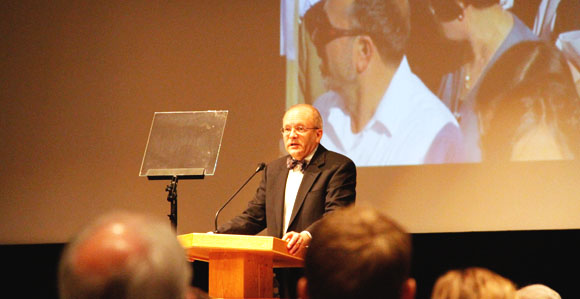Message of Christ Is Not Absent from Old Testament
Contributed By By Marianne Holman, Church News staff writer

Kent P. Jackson, a professor at Brigham Young University, speaks at the Sidney B. Sperry Symposium on October 26, 2013.
Article Highlights
- Easter is a fulfillment of Old Testament prophecy.
- Names given to Christ during His triumphal entry signify that many recognized Him as Jehovah, the God of the Old Testament.
- Each of the four Gospel accounts of Gethsemane ties the event to Old Testament prophecy.
“Modern revelation teaches us that Jesus Christ is Jehovah, the God of the Old Testament, and that ‘all things which have been given of God from the beginning of the world, unto man, are the typifying of him.’” —Kent P. Jackson, BYU professor
Related Links
PROVO, UTAH
“Easter is the culmination of the Old Testament,” Kent P. Jackson said during his keynote address at the 42nd Annual Sidney B. Sperry Symposium at Brigham Young University on October 26.
“Easter is the central celebration of our faith, the commemoration of the atoning sacrifice of our Savior, Jesus Christ,” the BYU professor said. “I am of the opinion that we don’t celebrate Easter very well in the Church, but we do celebrate the Easter events every Sabbath as we partake of the sacrament and commemorate the Atonement.”
In what he explained to be a “homily,” a sermon that is based on or follows the reading of a scriptural text, Brother Jackson focused his address on the Old Testament and Easter.
“Some homilies are associated with special events in the Christian calendar, as is this one,” he said. “And many, like this, have been the means of expressing thanks and joy for the goodness of God, in keeping with our themes of temple, praise, and worship.”
The theme of this year’s symposium was “Ascending the Mountain of the Lord: Temple, Praise, and Worship in the Old Testament.” Keeping his focus on three Easter events—Palm Sunday, Christ’s suffering in Gethsemane, and the Savior’s Resurrection—Brother Jackson explained that Easter is the central celebration of faith, and although they are recorded in the New Testament, they are Old Testament events.
“Our most fundamental communal meeting—sacrament meeting—has even in its name the emblems of Jesus’s suffering, death, and Resurrection,” he said. “Why the Old Testament and Easter? Modern revelation teaches us that Jesus Christ is Jehovah, the God of the Old Testament, and that ‘all things which have been given of God from the beginning of the world, unto man, are the typifying of him.’ Thus the Old Testament, like all our scriptures, is a testament of Jesus Christ.”
By examining the Easter events, individuals can see how each fulfills Old Testament prophecy and can tie the Old Testament and New Testament together. As one of the rare events in Jesus’s ministry that is recounted in all four of the Gospels, the triumphal entry—or Palm Sunday—marks the beginning of Holy Week and starts the celebration of the Savior’s Resurrection.
“So how is the triumphal entry a fulfillment of a millennial prophecy?” Brother Jackson asked. “When the Savior entered Jerusalem, He rode over the Mount of Olives and into the city in careful reflection of the events foretold in the prophecy. It is obvious from the record that all things transpired as they were intended as a means of identifying His actions with the foretold events of the distant future.”
The purpose of the triumphal entry was to proclaim who Jesus was, to identify the man Jesus of Nazareth with the Holy Messiah who would come at the end of time, Brother Jackson taught. Words drawn from all of the New Testament accounts—“Hosanna,” “King,” “Son of David,” “King of Israel”—make it clear that the people knew they were not welcoming just any Galilean rabbi to Jerusalem. Rather, they knew they were experiencing a biblical, Old Testament event.
“Titles like these were not chosen lightly by Jews in Jesus’s time but were reserved to identify messianic hopes,” he said.
Another Old Testament event recorded in the New Testament is the Savior’s suffering in Gethsemane. Accounts found in Matthew, Mark, and Luke share the Savior’s experience in the garden, describing the events of the night.
“Was this an Old Testament event?” Brother Jackson asked. “The Gospel writers thought so. Each account includes references to events of that night fulfilling Old Testament prophecy.”
Drawing from each account, Brother Jackson taught of ways each author contributed to the overall understanding of the Savior’s suffering in Gethsemane, fulfilling Old Testament prophecy.
The Resurrection of Jesus Christ is often characterized as the light of new life, Brother Jackson said. “In the Old Testament’s praise and worship, God is associated strongly with light. He is its source and provides its sustaining power.”
The association of God with light also plays a role in prophecies of the future, he said. “In Jesus’s own words and in those of the evangelists, the New Testament connects directly with our Savior these Old Testament images of God as Israel’s light.”
As the “true light,” “light of the world,” and the light that “shineth in darkness,” the Savior is being identified as Jehovah, the God of the Old Testament. The writers of the New Testament made connections and comparisons with the Old Testament.
“Believers in New Testament times had the same Old Testament text that we have today,” he said. “Through images, types, and shadows, it teaches us fundamental truth, but few of its passages are overtly centered on Jesus Christ. … The message of Christ is indeed not absent from the Old Testament. In this great book of scripture, faith and repentance are fundamental to the person and character of Israel’s God. His capacity to save is one of the hallmarks of His personality, and faith in His ability to deliver His people from every enemy teaches faith in His capacity to save from the greatest enemies—sin and death.”
